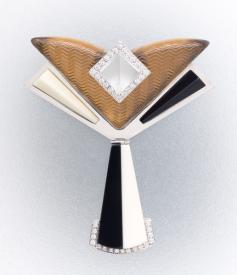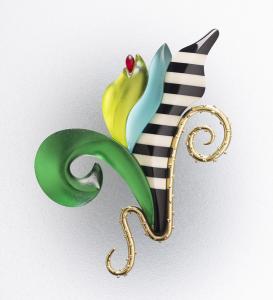
Susan Cummins: Please give us some idea of how you became the unusual combination of a glassblowing jeweler.
Linda MacNeil: To clarify, I don’t do any glassblowing. I work with glass in various ways to create specific parts and shapes and colors or to make solid masses of stock, which I can cut and grind to fit the metal parts of a specific piece.
I was experimenting with acrylics in 1972–73 when I met Dan Dailey, who showed me that glass can be an artist’s medium. Glass has diverse optical properties, an infinite range of colors, it can be similar to gemstones, similar to opaque minerals, similar to metal, yet it is unique. Glass is both ancient and contemporary.
Why do you make jewelry using glass?
Linda MacNeil: I have control over the color, the texture, and the quality of light falling on or passing through or refracting within my work. It is also completely my own, unlike a purchased gem or a custom stone.

Susan Cummins: Please give us some idea of how you became the unusual combination of a glassblowing jeweler.
Linda MacNeil: To clarify, I don’t do any glassblowing. I work with glass in various ways to create specific parts and shapes and colors or to make solid masses of stock, which I can cut and grind to fit the metal parts of a specific piece.
I was experimenting with acrylics in 1972–73 when I met Dan Dailey, who showed me that glass can be an artist’s medium. Glass has diverse optical properties, an infinite range of colors, it can be similar to gemstones, similar to opaque minerals, similar to metal, yet it is unique. Glass is both ancient and contemporary.
Why do you make jewelry using glass?
Linda MacNeil: I have control over the color, the texture, and the quality of light falling on or passing through or refracting within my work. It is also completely my own, unlike a purchased gem or a custom stone.
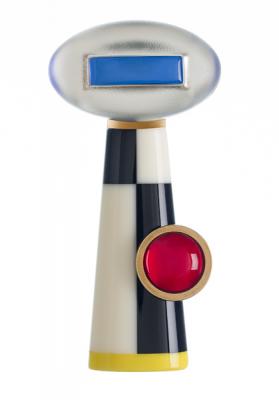
Linda MacNeil: My work is influenced by Art Deco, the jewelry of René Lalique (who made the greatest use of glass as a jeweler historically), the concepts of Mauboussin, the paintings of Mondrian, ancient Egyptian sculpture combining glass and gold, the fabricated precious works of Salvador Dali, and many other artists’ works. For 40 years I have visited museums, observing details in any kind of art that intrigues me. My sketchbooks are filled with thoughts gained from these observations.
Does your work contain ideas, concepts, or aesthetic language beyond the decorative?
Linda MacNeil: The decorative arts have been a strong influence, and like many designers and artists of the past, I incorporate and adapt certain aesthetic concepts from anything that catches my eye. Therefore, it is observation, thinking over what I have seen, and experimenting with form and materials, which results in the art I have made.
Similar to a sculptor working at a larger scale, my work begins as a sketch, evolves as a three-dimensional form, and is fit to a functional format. Making jewelry with a sculptural approach requires a balance between the look that I want and the wearable feel necessary to the user’s pleasure.
I don’t make statements, political or sociological. I don’t rely on the found qualities of elements combined to inspire the piece. I prefer to begin with a thought and draw what I imagine, beginning with sheet, rod, tubing, or wax for cast parts, and often creating plaster models for the parts I intend to cast or otherwise form with glass. I often cut, drill, grind, file, sand, sandblast, and acid polish or mechanically polish the glass. These hands-on processes define my work and constitute my material palette.
The processes inspire certain ways of approaching form, so when I draw an idea for the first time, I am already thinking in terms of specific metal- and glass-forming techniques. Although this determines the look of my work, what I make comes from a pursuit of visions that occur to me and I feel the need to articulate as objects.
Your jewelry displays an unusually large variety of forms and colors given your use of glass, which you can make from scratch. With such infinite possibilities, how do you go about planning a piece?
Linda MacNeil: As described above, the vocabulary of materials and processes I have accumulated allows me to imagine shapes and combinations as I draw. The drawing stage of a piece is important because it sets my path toward the work ahead, allowing me to visualize the necessary steps to completion. Perhaps because I have developed many ways to combine glass and metal, the numerous possibilities offer me a great deal of freedom to design.
I am methodical, and I like to proceed in familiar ways. So beginning with drawings, making models and templates, cutting or forming parts, combining and fabricating parts, assembling, and finishing all occur in the traditional manner of my predecessors. Yet, I may feel uncertain about a piece at some point and put it aside to wait for a fresh perspective. Some pieces remain in progress for years. As a result, I have numerous pieces under way at any given time.
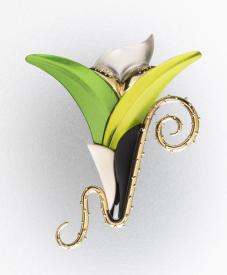
Your show at Mobilia is all brooches. Is that your usual format, or do you do necklaces, rings, and earrings, too? What were you investigating with this series?
Linda MacNeil: Although I have made a few rings, it has never been a focus of my art. Occasionally, I make earrings as part of an ensemble when making a necklace. Since I have no regular production of works for a given market, I think of each piece as a single work of art and take the necessary time to develop it until I reach a point of certainty with my creation.
The brooch offers a bit more sculptural freedom than a necklace, because it can be pinned to a garment and remain fixed against a visual background. I have this in mind as I sketch the piece.
Two groups of brooches are shown at Mobilia: abstracted Floral forms and Geometric constructions. The Floral designs are fantasies, elaborately celebrating certain parts of flowers. The Geometric designs begin with black and white so every added color stands out vividly. I like to emphasize graphic contrast and linear division. Two or three works in this show depart from these described series, but they relate to previous pieces I have made—Lucent Lines, Stellar, Proud, and Brilliant Peril II. Emphasizing the brooch allowed me to concentrate on the contrasts from piece to piece within self-imposed limits of the format.
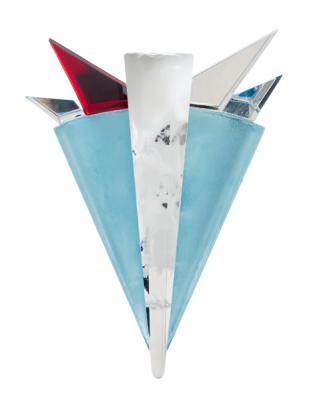
Linda MacNeil: Teaching is not my strength. Although I have worked with students at summer programs, I prefer time in the studio to time in the classroom. It seems to me that I always have more ideas for new work and many works in progress, so I am thoroughly engaged in my art. I also have many activities unrelated to art, so I don’t need to add any more to the mix.
My husband, Dan Dailey, taught for more than 40 years, so we have enough teachers in the studio we share. He has eight assistants working with him to produce his art, therefore I don’t work alone, and I am always conversing about my projects and often learning something new.
What can you recommend to read or to see that has recently made an impression on you?
Linda MacNeil: Antoni Gaudí’s La Sagrada Família in Barcelona, Spain, is incredible and so full of styles, attitudes, messages, and references to nature. It is impossible to describe. The materials combined and the quality of craftsmanship are beautiful and powerful. Gaudí’s unconventional ideas and the asymmetrical monumental design of structural columns and arches are astounding. His mix of medieval and contemporary forms presents constant surprises that are thoroughly appreciated by multitudes of visitors. If you can get past the tourists and see the cathedral, especially from the highest towers, in detail over some hours, it is an unforgettable experience. I found it truly inspiring.
Thank you.
